Yoshimura history -26
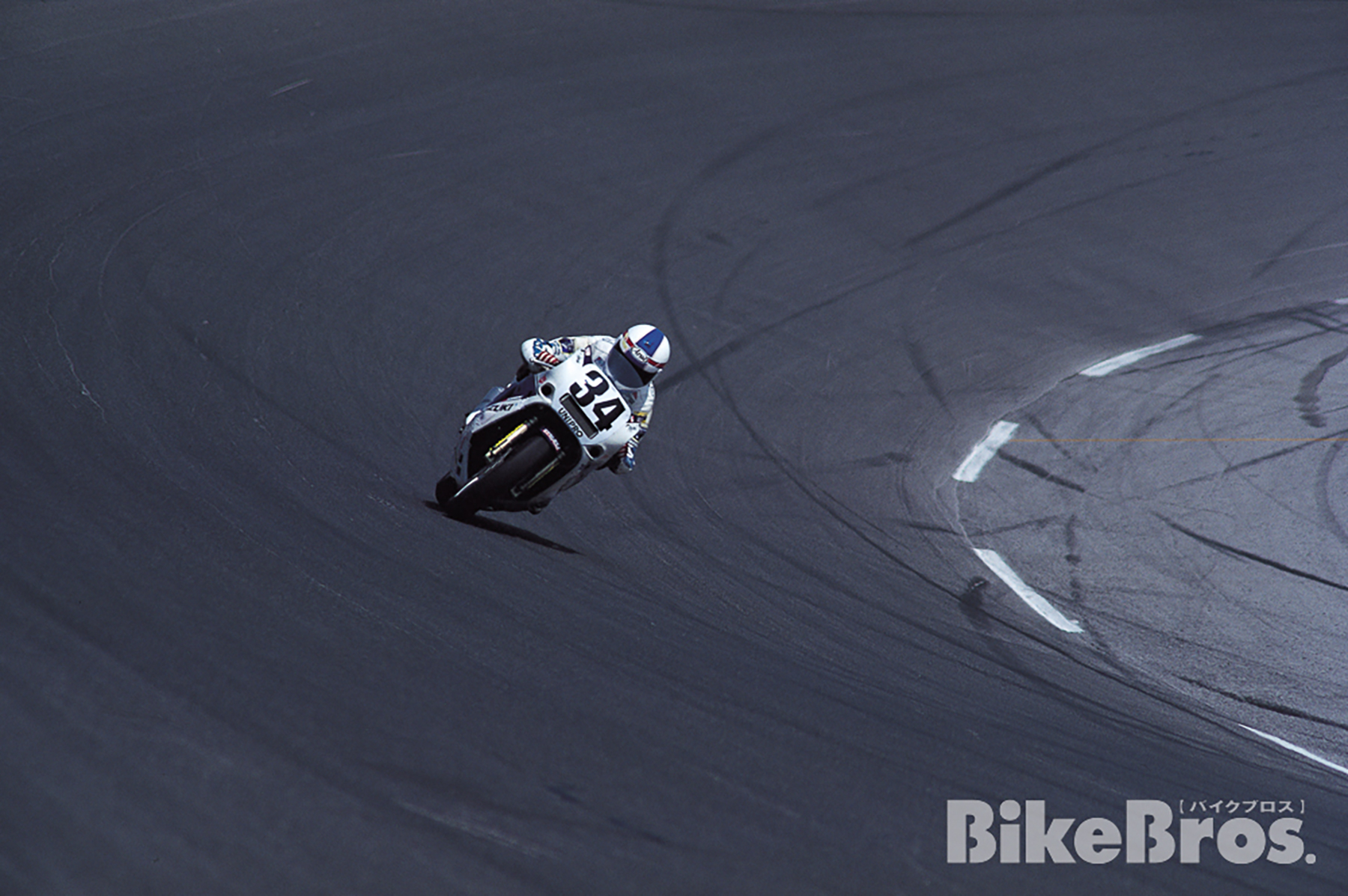
Schwantz was the only Yoshimura rider to compete in the 1988 Daytona 200 on a GSX-R750J. This photo depicts the section where riders race down the 31-degree banking and then head into the near-flat straight (after which they head up the 18-degree banking by the grandstand). The intense vertical G-force causes the front and rear suspensions to bottom out momentarily.
Schwantz’s First Daytona 200 Win
1988 Part 1: The Texan Wins the Biggest Race of His Life.
The 1988 season of world road racing began, as always, with the Daytona 200-mile race. This was the fourth year since the Daytona 200 had switched from Formula 1 (2-stroke 750cc / 4-stroke 1025cc) to Superbike formula (4-cylinder 750cc / 2-cylinder 1000cc). Yoshimura Suzuki assigned the latest 1988 GSX-R750J model to Kevin Schwantz, and the previous model to Doug Polen, Scott Gray, and Yukiya Oshima, who was traveling from Japan. Schwantz was competing in the event as a spot entry, and after Daytona he was scheduled to compete in the 500cc World GP full-time on a Suzuki RGV-Γ for Pepsi Suzuki. Oshima was there as a reward for winning the 1987 All Japan TT-F1 Championship, which was the third of Pop’s promises to take the All Japan Champion to Daytona (the first two were for Satoshi Tsujimoto), and he was also there as a spot entrant.
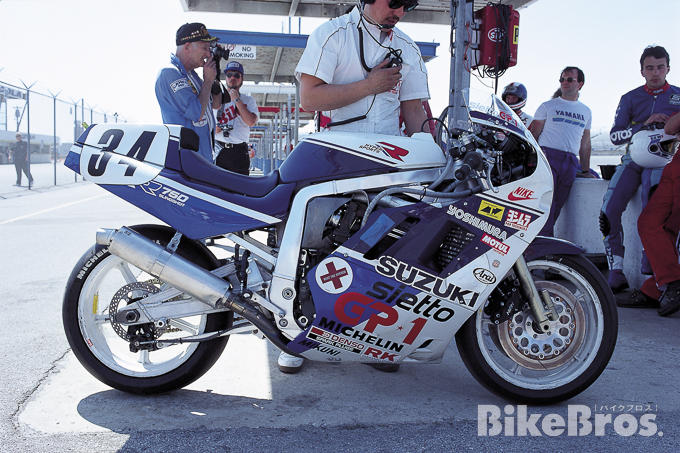
The GSX-R750J was powered by a super-short-stroke engine that was unique in the 4-cylinder 750cc class. Its φ73mm bore was unheard of in 1988, as even φ72mm is rare, and was only used on the 1993 Yamaha YZF750R/SP, the 1994 Honda RC45, and the 1996 Suzuki GSX-R750T. The φ73mm bore was not seen again until the 1996 Kawasaki ZX-7R/RR’s debut.
Although the 1988 “J” model was able to obtain AMA homologation just in time, it took so long to develop that Yoshimura was only able to prepare one bike for Schwantz. The bore and stroke of the previous model was φ70 x 48.7mm (749.7cc), whereas the 1988 J had a super-short stroke of φ73 x 44.7mm (748.3cc), and the φ73mm was a big bore that had never been attempted in the 750cc class. In AMA races, 1mm oversize pistons were allowed (stroke could not be changed), so the previous model could use a φ71mm piston (770.86cc), and Tsujimoto was so impressed saying, “It’s more powerful than the TT-F1 and it’s exciting” (TT-F1 races allow a 1% increase in displacement by increasing the bore for repairs). It’s only 20cc, but that 20cc makes a big difference. However, the development of φ73mm bore short-stroke engine faced difficulties, with the first one being completed just in time for Daytona Bike Week.
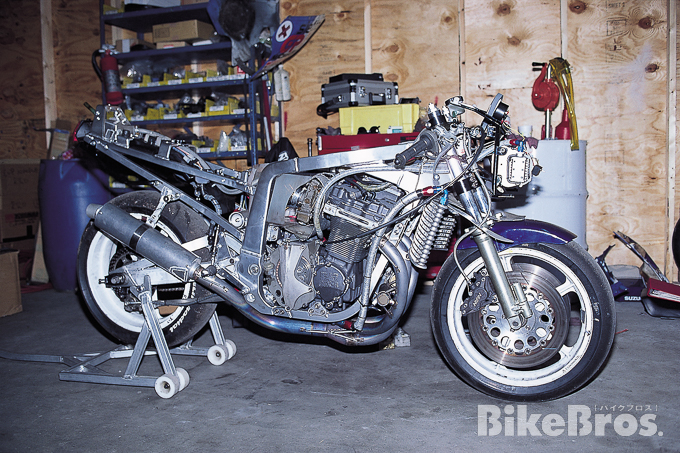
The GSX-R750J for Schwantz features 17-inch Tecnomagnesio magnesium rims front and rear, fitted with Michelin radials (12/60 front, 18/67 rear). The oil cooler behind the front fairing is for cooling the cylinder head, and the large, curved oil cooler is for lubrication. The carbs are φ40mm magnesium Mikuni square flat-slides with roller-bearings to ensure smooth operation of the throttle valves. The clutch is dry. The exhaust system is a Yoshimura Duplex Cyclone 4-into-1, with φ42.7mm titanium exhaust pipes, a titanium tailpipe and an aluminum silencer shell.
Schwantz, who rode the 1988 J at Daytona, said, “You lose 1 second on the outer track, but you gain 2 seconds on the infield.” Just as he said, the chassis performance was high, and the aluminum double cradle frame was definitely more rigid than previous model (in Superbikes, the main frame cannot be changed, but the swing arm can be replaced or modified), yet the short-stroke high-revving engine was less powerful than its predecessor. In fact, Fujio had already expected such a reaction from the riders even before the season opened, as it had been revealed in the dyno tests during development.
Daytona’s unique Qualifying Timed Practice session determines the top 10 starting grid, and the grid for positions 11 to 60 is determined by the results of a 50-mile heat race, while positions 61 to 75 are determined by the Qualifying Timed Practice results, and positions below that are determined by the Qualifying Timed Practice results and the previous year’s ranking (Camel Pro Series).
Schwantz’s pole position time of 1:55.110 in this Qualifying Timed Practice was unfortunately not enough to beat Freddie Spencer’s record of 1:54.572 from the previous year on a HRC Honda VFR750F (Spencer did not participate in the final race). The 2nd position was taken by Bubba Shobert (AMA Grand National dirt-track champion from 1985 to 1987) riding an American Honda VFR750F, but the Team Yoshimura dominated the top positions, with Polen in 3rd position, Oshima in 4th position with a 1:57.007, and Gray just behind them. Oshima was not happy with the result, as he had not been able to reach Tsujimoto’s record time of 1:55.765 set in the previous season, even though the circumstances were different.
Schwantz, however, fell off his bike during the free practice session on the Tuesday afternoon of the race week, after running off the track and into the grass at the chicane between the back straight and the 31-degree banking. He said that it didn’t affect his riding, but he had hurt his left wrist and right ankle.
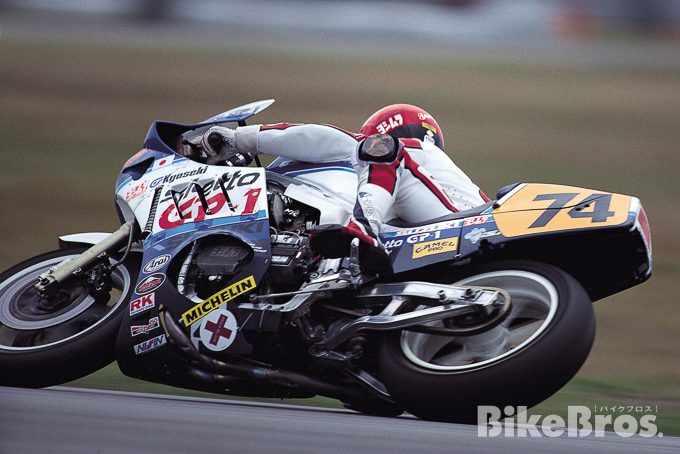
Following Tsujimoto in 1986-1987, Oshima also received high acclaim in the U.S. road racing scene, with people saying, “All the Japanese riders Yoshimura brings are fast.” Oshima rode a previous-model GSX-R750, with Michelin tires the same as Schwantz’s. Non-AMA riders with overseas licenses used to wear 3-digit numbers, but since 1988 they began wearing 2-digit numbers on yellow backgrounds.
The 15-lap 50-mile heat races held on Fridays are divided into two groups. In Heat 1, Schwantz, Polen, Gray, and others who finished in odd-numbered positions (PP, 3rd, 5th, and so on) in the Qualifying Timed Practice will compete, while in Heat 2, Shobert, Oshima, and others who finished in even-numbered positions (2nd, 4th, and so on) will compete.
In Heat 1, Schwantz, Polen and Gray of the Team Yoshimura were challenged by privateer Mike Baldwin on a Honda VFR750F. Schwantz broke away from the pack to win the race, with Polen in 2nd and Gray in 3rd, making it a Yoshimura 1-2-3 sweep.
In Heat 2, Shobert took the lead. Oshima overtook Anders Andersson (Team Sweden Suzuki) on the 2nd lap to take 2nd position. Shobert was pushing hard, setting a lap time of 1:56s to beat Schwantz’s 1:57s from Heat 1, but he crashed out on Lap 7 at Turn 2, 3 seconds behind Oshima. Oshima took the lead without difficulty. He then won the heat by a comfortable margin of 17 seconds, becoming the second Japanese 50-mile winner after Tsujimoto (Heat 1, 10 laps) the previous year.
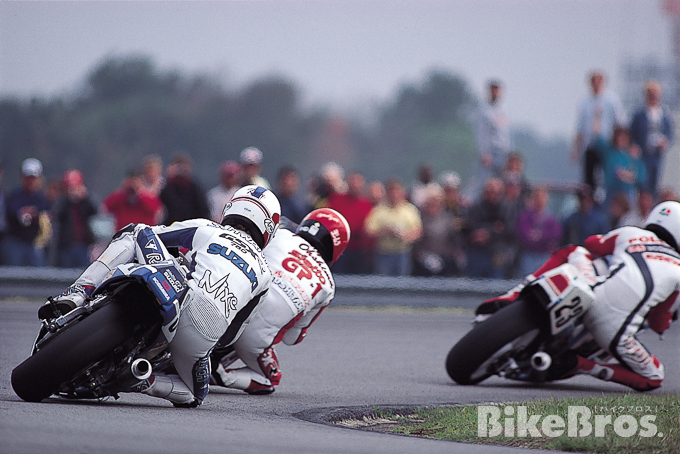
The Daytona infield in the early stages of the 200-mile final race. Polen in the lead, Oshima in 2nd and Schwantz in 3rd. As befits the “King of Prize Money,” Polen held the lead at the end of Lap 5 and earned the Camel Challenge’s $10,000.
Due to the rain on Sunday, the schedule was pushed back, and the “Camel Challenge” prize race, which was originally supposed to be held over 5 laps before the 57-lap, 200-mile final race, was incorporated into the first 5 laps of the final. The top three finishers in each of the 50-mile heat races (a total of six riders) were eligible to compete in the Camel Challenge, with the winner taking home a massive $10,000, 2nd place $2,500, 3rd place $2,000, 4th place $1,500, 5th place $1,000, and 6th place $500. In other words, if you wanted to win the prize money, you needed to be in first position at the end of the opening 5 laps of the 57-lap final.
There was an odd feeling in the air right from the start of the final race. During the warm-up lap, Shobert’s Honda V4 on the 2nd grid stalled due to a vapor lock somewhere between the fuel hose and the carburetor. Ricky Johnson (1986 & 1988 AMA 250cc Supercross Champion), a motocross star who was in Daytona as a helper for American Honda, pushed the machine back onto the grid with all his might, but it ended up at the back of the pack at the start.
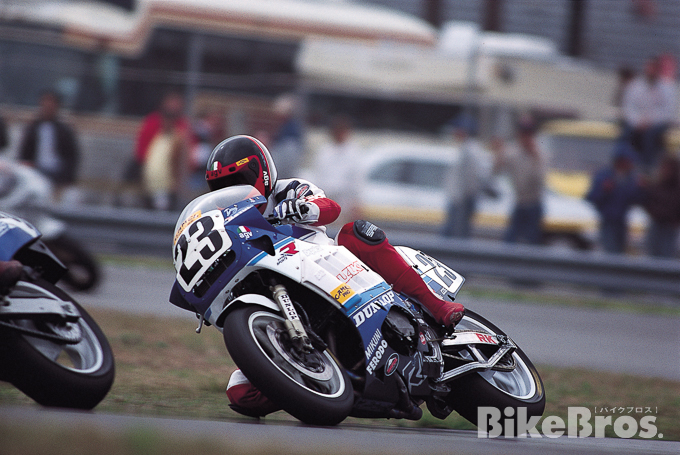
From Prize Hunter to Contract Rider. Polen got his first big contract in 1988. It was the first time he had been guaranteed a full season. His GSX-R750 was a previous model, but it was more powerful than the new “J” model, and because of that he was able to shake off Schwantz in the Camel Challenge. His bike wears Dunlop tires.
Then the 5-lap super sprint race began. The pace was fast, with lap times in the low-1:57s. This was not a pace that would last for the full 57 laps. Schwantz, Polen, Oshima, Gray, Andersson, and Gary Goodfellow (Don Knit Sugano Racing Team) all on GSX-Rs, raced hard. Schwantz, Polen and Oshima broke away from the pack, and Polen held off Schwantz by a bike length to cross the finish line on the 18-degree banking to take the $10,000 top prize. Oshima finished 3rd. Schwantz later said that his goal was to win the 200-mile race, and it seemed as though he had given the Camel Challenge victory to his fellow Texan, Polen. The difference in circumstances surrounding these two riders –––– Schwantz, who had secured a seat as an ace rider in the 500cc GP series with a high signing bonus from Suzuki, and Polen, the prize money champ of local races who had finally managed to secure a full-season contract with Yoshimura –––– was perhaps apparent in the first 5 laps.
After that, Schwantz, Polen and Oshima took turns leading the race, and there was even a lap when Oshima crossed the finish line in first position. On lap 12, Schwantz began to pull away, raising his pace to the 1:56 bracket, while Oshima, who had been reporting problems with the front end of his bike since the beginning of the race week, crashed at Turn 1. Oshima managed to restart, but was far behind.
Then, Schwantz took the lead, followed by Polen and then Gray. On Lap 19, the leader Schwantz made his first pit stop. After refueling in just 10 seconds, he left the pit. In the meantime, the lead was taken over by Polen. On the next lap, Polen came into the pit for refueling and rear-tire change, but it took longer than usual to remove and reinstall the rear axle, taking more than 10 seconds. By the time Polen returned to the track, the gap to the leader Schwantz had grown to 24 seconds.
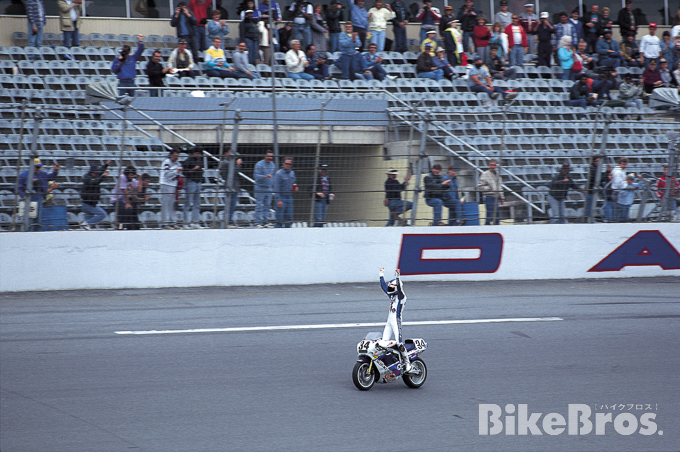
Schwantz won the Daytona 200 for the first time in 1988, finishing 90 seconds (3/4 laps) ahead of 2nd place. Here, he responds to the cheers of the crowd by standing up with his hands in the air, a feat that is extremely difficult to pull off on the 18-degree banking by the grandstand.
Lap 38 saw Schwantz put Shobert, who had moved up from the back of the pack to 5th, a lap down. On Lap 39, Schwantz made his second pit stop with plenty of time to spare. Having refueled and changed the rear tire, he then went on to win the race by a margin of 90 seconds. “I’m very happy. It was a close race at the beginning, but everything went smoothly after that,” Schwantz expressed his delight after the race.
2nd place went to Polen, who earned a total of $20,820, more than the $18,435 won by Schwantz. The $10,000 Camel Challenge prize made a difference. 3rd place went to Shobert. Oshima completed 51 laps and finished 45th. “The front end was somewhat twitchy, and the bike went into an oversteer at the 1st corner. After that, I just focused on finishing the race. I’m ashamed of myself, and I need to practice more,” Oshima reflected. It was indeed a disappointing result, but it was a worthwhile achievement for him to be able to demonstrate his speed and potential in his Daytona debut.
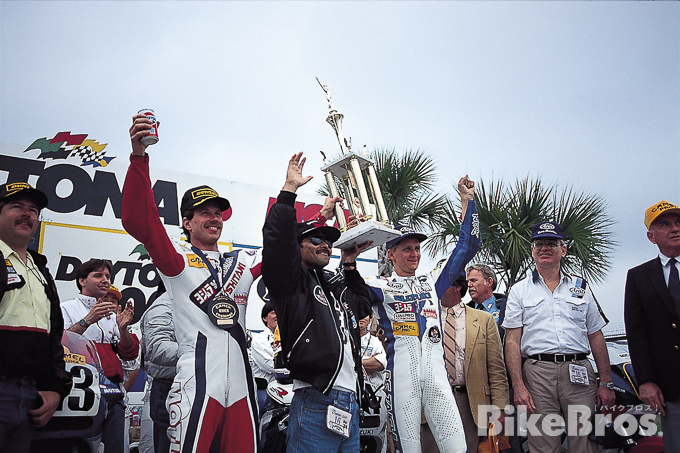
Three men standing in the Victory Lane at the 1988 Daytona 200, beaming with joy. Polen (left) was satisfied with his 2nd place finish, his first achievement since signing a full-season contract, while Fujio (center) was overjoyed at winning Daytona for the first time since Wes Cooley made it happen in 1981, and also for winning with the GSX-R750, and what’s more, for the team’s 1-2 finish. Schwantz (right) was overwhelmed with emotion as he finished the biggest race in his home country, which he was about to leave, with a win, and with a sense of both parting and anticipation of new challenges. Three different smiles were on display.
After that, the 1988 AMA Superbike series featured a one-on-one battle between Doug Polen and Bubba Shobert. At the opening round at Daytona, Polen came in 2nd and Shobert came in 3rd. At the Round 2 at Road Atlanta (Braselton), Polen came in 2nd and Shobert came in 1st. At the Round 3 at Bryar (Loudon), Polen came in 1st and Shobert came in 2nd. At the Round 4 at Road America (Elkhart Lake), Polen came in 1st and Shobert came in 2nd. At Round 5 at Laguna Seca (Monterey), Polen finished in 2nd place and Shobert won. At Round 6 at Mid-Ohio (Lexington), Polen finished in 6th place and Shobert won. At Round 7 at Sears Point (Sonoma), Polen won and Shobert finished in 2nd place. As a result, the 1988 season ended with both riders having won three times each. Polen finished on the podium six times, while Shobert seven times. In terms of points, Polen came 2nd with 117 points, and Shobert was crowned champion with 121 points. The difference was that in Round 6, although Polen had taken pole position, he failed to make it onto the podium (Polen took PP six times out of seven rounds, with Schwantz taking the other). Meanwhile, Shobert’s performance in the opening round, where he started from the back of the grid after stalling on the warm-up lap, but still managed to catch up and finish 3rd, was a big advantage.
In that same year, Polen rode a Suzuki GSX600F Katana to win two of the nine races in the AMA 600 Supersport Championship series, and rode a GSX-R750 to win five of the nine races in the AMA 750 Supersport series, becoming champion in both series. If he had also won the Superbike championship, he would have become the first rider in history to win the Triple Crown. It was only a difference of four points that prevented him from achieving this. For Polen, 1988 was a very busy year. He competed in three different classes in the AMA road racing series, made a spot appearance in the All Japan series, and entered the Suzuka 8 Hours, taking part in over 80 races in total. It was only through Polen’s exceptional talent and physical strength that he was able to compete in so many top-class events.
Published on April 10, 2024
Stories and photos supplied by Yoshimura Japan / Vega International / Shigeo Kibiki / Takao Isobe / Tatsuo Sakurai
Written by Tomoya Ishibashi
Edited by Bike Bros Magazines


